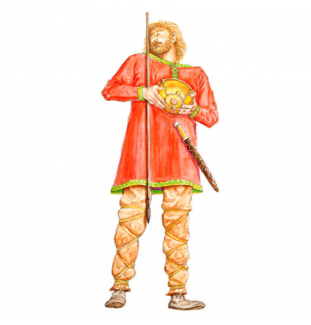
In August 1930, archaeologists arrived on the site of the old earthwork at Oliver's Battery, two miles to the south-west of Winchester. As they dug into the ditch, they discovered the skeleton of an Anglo-Saxon man, aged 25 to 30, about 5 feet 9 inches tall. On his breast was a rare and beautiful bowl of beaten bronze, with bright red enamelled fittings and suspension hooks each one in the shape of a heron's head.
There were two other objects with the burial, a fine 'seax' or long knife with a silver pommel, probably used for hunting, and a javelin, now very fragile and corroded. Local archaeologist W J Andrew had set out to investigate the date of the earthwork, and instead turned up this unexpected find- which, at least showed, of course, that it must be earlier than Anglo-Saxon, and not constructed by Oliver Cromwell's troops, even if it had been used by them.
The prominent position of the grave on the earthwork and the quality of the grave goods proclaim the high social status of the dead man. As the bowl was dated to the late 7th or 8th century, he may have been amongst the last in Winchester to have been buried in the pagan Anglo-Saxon manner, rather than in a churchyard. The provision of the bowl may also express hopes for him in the next world at a time when many had been converted to Christianity, but the old heroic ways of life- and death- had not quite passed.
The burial finds an echo in the Anglo-Saxon epic poem Beowulf, which itself describes a way of life that was gone by the time it came to be written down in the 8th century.
'Bid men of battle build me a tomb
fair after fire, on the foreland by the sea
that shall stand as a reminder of me to my people
towering high above Hronesness
so that ocean travellers shall afterwards name it
Beowulf's barrow'...
'They left the earl's wealth in the earth's keeping
the gold in the dirt, it dwells there yet'...


